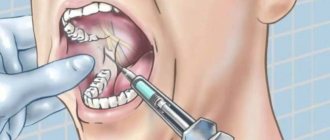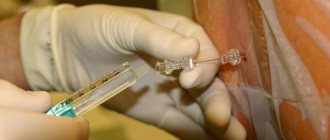Conductive blockade
- one of the effective ways to relieve pain symptoms.
The mechanism of its action is based on blocking nerve impulses that transmit information to the brain about the existing source of pain. This allows you to temporarily reduce the pain threshold and perform surgery. However, conduction anesthesia
can be used not only as one of the elements of modern anesthesia, but also as a therapeutic agent in patients who suffer from chronic pain syndrome. Thanks to it, the effect of pain relief will be achieved as quickly as possible, while the risk of complications will be minimized. Conduction anesthesia in Moscow can be performed in the multidisciplinary clinic CELT. We employ experienced specialists who have modern equipment and effective drugs at their disposal.
At CELT you can get advice from a specialist algologist.
Make an appointment
Peripheral blockade under ultrasound navigation RUB 5,000.
15 minutes
(duration of procedure)
Types of conduction blockades
Types of conduction anesthesia
are distinguished based on various parameters:
- method of influence;
- drugs used;
- purpose of application;
- localization;
- developer
All types of blockades are presented in the table below:
| View | Peculiarities |
| Drug therapy | |
| Local: periarticular, perineural | The injection is made directly into the site of the lesion, around the affected areas or under them: into periarticular tissues or channels through which nerves pass |
| Segmental: paravertebral, vertebral | They have an analgesic effect through crossed nerve fibers. Provide for the introduction of drugs into the paravertebral region in order to relieve pain, reduce swelling, relieve spasms |
| Classification by drugs used | |
| Monocomponent | One drug is used |
| Dicomponent | Two drugs are administered |
| Multicomponent | More than two drugs are used |
| Classification by purpose of use | |
| Medicinal | A safe technique that eliminates pain syndromes or is part of a complex treatment for pathologies accompanied by severe pain |
| Diagnostic | Aimed at identifying the causes of pain as accurately and quickly as possible and making the correct diagnosis. The mechanism of conduction pharmacological blockade is such that when an anesthetic is introduced into the “pain generator” it subsides, thanks to which the doctor is able to make a more accurate diagnosis |
| Classification by localization | |
| Spinal block: intercostal, lumbar, neck | It has an analgesic and therapeutic effect, allows you to treat vertebral hernia, and is carried out under the control of a fluoroscope. It is used for the following diseases:
|
| Joint blockade: knee, shoulder | Relieves pain, restores mobility and function of the limbs, injection is carried out directly into the affected area. Applicable for:
|
| Sciatic nerve block | The drug is administered directly into the nerve, thereby blocking the transmission of impulses along the nerve trunk. Allows you to eliminate pain, inflammation, spasms |
| Classification by developer | |
| According to Vishnevsky: intrapelvic, intercostal, intravenous, paravertebral | Different types of conduction novocaine blockades, which are carried out to interrupt pain impulses during:
|
| According to Catlen | The injection is carried out into the opening of the sacral canal and is used for osteochondrosis |
Advantages and disadvantages
For simple surgical interventions, local anesthesia is indispensable; it has advantages over other types of sensitivity suppression. The drug that is used, an anesthetic solution, acts strictly at the injection site, which helps to avoid severe complications and adverse reactions.
The blockade of pain sensitivity develops on average in 10-15 minutes. The effect lasts for an hour or more, so local anesthesia can reduce pain in the area of the postoperative wound. The patient’s consciousness does not suffer from the action of the local anesthetic, so after the manipulation he can leave the clinic and not be in the ward.
But local anesthesia has its drawbacks. Just a few years ago, it was widely used for operations on superficial tissues and extremities; methods for intravenous administration of drugs with simultaneous application of a tourniquet were developed. Intraosseous anesthesia was widely used. But due to the large number of adverse reactions and complications, these methods began to be used less frequently. And after receiving high-quality drugs for anesthesia, dangerous methods of pain relief were practically abandoned.
The disadvantage of the local method is its limited scope of application. It is effective for anesthesia of mucous membranes, skin and superficial tissues, but is not used for operations on the abdominal and pelvic organs, neck and head.
The infiltration type of local anesthesia cannot be used when operating on malignant tumors due to the possibility of tumor cells entering beyond the wound into other tissues. This increases the risk of developing metastases.
What medications are used?
Conducting conduction anesthesia
involves the use of various medications. Their selection is carried out individually, depending on the patient’s indications and the characteristics of the case. We invite you to familiarize yourself with the features of the drugs that are most often used during conduction blockades. They are presented in the table below:
| Drug name | Peculiarities | Advantages and disadvantages |
| "Novocaine" | It is a transparent solution with a percentage of 0.25% to 2%. It is most often used for blockades | Provides a quick pain relief effect (within 2 - 7 minutes), which lasts about 2 hours. May cause allergies and vascular reactions |
| "Lidocaine" | A frequently used drug that has an increased therapeutic index | It is characterized by low toxicity, high permeability, absence of allergic and other negative reactions. Provides pain relief effect for several hours |
| "Merkain" | Local anesthetic, has an analgesic effect no earlier than 10-20 minutes after administration. Used to block peripheral nerves | It has a prolonged effect, which can last from 3 to 5 hours. May have negative effects on the kidneys, liver and heart |
| "Hydrocortisone" | Steroid hormone in the form of a suspension for injection | Requires mixing with anesthetic. Gives good results when performing intra-articular blockades |
| "Dexamethasone" | A hormonal drug whose activity is thirty times higher than that of Hydrocortisone. Used for blockades of soft tissues and joints | Does not affect electrolyte metabolism. Has a quick but short-lasting effect |
Abstract of the dissertation for the scientific degree of Candidate of Medical Sciences
Scientific supervisor: Doctor of Medical Sciences, Professor A.K. ROVINA
Official opponents: Doctor of Medical Sciences, Professor V.N. KOKHNO Doctor of Medical Sciences, Professor V.N. LOMIVOROTOV
general description of work
Relevance of the topic.
Trauma to the upper extremities ranks first in the structure of general traumatism and is more common in people of young, working age, and the high surgical activity in the treatment of these injuries gives the problem of pain relief from operations on the upper extremities medical and social significance. The choice of anesthesia method depends on the nature of the injury, the patient’s age, his concomitant diseases, the position on the operating table during surgery, and on the tasks and conditions of the postoperative period (Nelzina Z.F., 1980; Kolontai Yu.Yu. et al., 1983 ; Thillaye et al., 1984; Kuzmenko V.V. et al., 1985; Malova M.N., 1985). At the same time, all things being equal, pain relief should be simple to perform and as safe as possible for the patient and medical personnel (Vishnevsky A.A. et al., 1963; Darbinyan T.M. et al., 1981; Polyakov V. A., 1981). To a greater extent, these requirements are met by plexus methods of anesthesia of the upper extremities (Pashchuk A.Yu., 1970, 1987; Jaqo et al., 1984). Existing methods of PS anesthesia differ from each other not only in determining the point of injection of the injection needle and access to the trunks of the plexus, but also in the composition, volume, concentration of the local anesthetic and auxiliary agents used, as well as the position of the patient’s body, head, and upper extremities at the time of conduction anesthesia. . In addition, each of the methods has disadvantages, because it is characterized not only by the percentage of failed anesthesia, but also by the proportion of possible complications (Svetlov V.A. et al., 1986; Schmidt und and., 1981; Kuflik et al., 1986) . When analyzing the causes of neurological disorders, three main factors are distinguished: mechanical, ischemic, chemical or toxic. Different authors attach different importance to the role of these factors, which is associated with different blockade techniques, instruments, choice of local anesthetic and auxiliary agents (adrenaline). The lack of a common point of view is also due to the inability to adequately assess the functional state of nerve trunks after anesthesia using objective criteria, such as electromyography. Most studies are hampered by plaster immobilization of the limbs and the inappropriateness of active movements of the muscles of the operated limb in the postoperative period. The accumulation of a significant number of practical and experimental observations strongly dictates a revision of the technique of conduction anesthesia and its capabilities in order to increase the efficiency and quality of blockades, reduce the number of complications, primarily neurological.
Goal of the work.
To develop and scientifically substantiate the optimal option for anesthesiological care in trauma patients during operations on the upper extremities based on conduction anesthesia of the brachial plexus and sedation with Diprivan. To achieve this goal, the following tasks were identified:
- To develop an algorithm for selecting and implementing options for conduction anesthesia of the brachial plexus.
- To provide a comparative assessment of various options for combining conduction anesthesia of the brachial plexus with drugs for intravenous anesthesia and to identify the most optimal ones.
- To assess the adequacy of anesthesia based on the dynamics of the most informative biochemical parameters in trauma patients undergoing operations on the upper extremities.
- To determine the nature and frequency of registration of complications during brachial plexus blocks, depending on the access used and anesthesia technique.
- To study the relationship between post-anesthetic neuropathy, the technique of brachial plexus block and the composition of the local anesthetic solution in the anesthetic management options used in trauma patients.
Scientific novelty.
A fundamentally new approach to the choice of PS blockade technique has been developed and scientifically substantiated. Its anatomical and physiological basis is given. For the first time, the adequacy of the proposed method was assessed based on hormonal homeostasis data. Optimal methods for monitoring the level of consciousness during traumatological operations performed under regional anesthesia are proposed. It has been established that using the technique of slowly advancing the needle, carefully performing aspiration test in case of technical difficulties during the brachial plexus block (long-term search for nerve trunks, unintentional puncture of blood vessels) allows one to avoid specific complications of conduction anesthesia.
Practical value.
Methods of the most effective conduction anesthesia have been developed and implemented, acceptable for patients of various age groups and constitution types, providing the ability to perform any surgical interventions on the upper extremities, including the shoulder joint and acromioclavicular joint. The volume, concentration, and composition of solutions for anesthesia, brachial plexus, and the most effective combinations of sedation agents were determined. The proposed methods are simple and do not require special equipment. The proposed option is technically simple, which facilitates training in the process of training an anesthesiologist-resuscitator. The developed method makes it possible to expand the indications for surgery in high-risk patients with severe concomitant pathology. The use of modern, long-acting and low-toxic local anesthetics (anecaine, marcaine) allows you to safely increase the duration of surgical anesthesia from 3 to 6 hours, effective postoperative anesthesia to 16 - 18 hours. The developed method can significantly reduce the frequency of complications and reduce the time of treatment in the hospital, which has a significant economic effect.
Provisions submitted for defense.
- Brachial plexus block from the supraclavicular approach is the method of choice for trauma surgeries on the upper extremities.
- The combination of conduction anesthesia with continuous intravenous infusion of diprivan is the optimal method of anesthesia for trauma surgeries on the upper extremities.
- The introduction of lidase into a local anesthetic solution promotes the development of an effective block of the brachial plexus, despite the absence of characteristic paresthesias.
Implementation of work results.
The developed technique of balanced regional anesthesia based on brachial plexus block, in combination with various combinations of selective drugs, was introduced into the practice of the department of anesthesiology and intensive care of the State Regional Clinical Hospital of Novosibirsk, and into the educational process at the course of anesthesiology and resuscitation of the medical faculty of the Novosibirsk Medical Institute.
General clinical characteristics of patients and research methods.
An analysis of the characteristics of PS anesthesia was studied based on the results of 1068 PS blockades in 1062 patients aged 16 to 83 years who underwent planned and emergency traumatological operations on the upper extremities.
Six of these patients were operated on twice under general anesthesia. Patients, depending on the tactics used to perform BPS, were divided into 2 groups: 1st - control, it included 568 patients. In this group, BPS was performed using one of the following methods: axillary, supraclavicular, interscalene. The choice of access for anesthesia of the brachial plexus was carried out in accordance with the recommendations of domestic authors (Pashchuk A.Yu., 1987; Kuzmenko V.V., Khamraev Sh.Sh., Skoroglyadov A.V., 1990; Kuzin M.I., 1993) . 2nd - the main one, includes 500 patients in whom BPS was carried out in accordance with the algorithm we developed. In terms of age, gender, body weight, type of constitution, nature of injury and operation, patients in both groups were comparable. In all age groups, there is a predominance of males - 53%. Patients of working age accounted for 87.6%. Among the patients we examined were patients with unconsolidated and consolidated fractures of the bones of the shoulder, forearm and hand, including complicated ones, as well as with habitual shoulder dislocations, ruptures of the acromioclavicular joint, injuries to muscles, tendons and nerves (Table 1). Distribution of patients by nature of the disease No.
| NATURE OF PATHOLOGY | Number of patients | Percent | |
| 1. | Fractures, shoulder dislocations | 314 | 29,4 |
| 2. | Forearm fractures | 186 | 17,4 |
| 3. | Fractures of the hand | 92 | 8,6 |
| 4. | Acromioclavicular joint ruptures | 96 | 8,9 |
| 5. | Damage to muscles, tendons and nerves | 280 | 26,2 |
| 6. | Dupuytren's contracture | 69 | 6,5 |
| 7. | Others | 31 | 3,0 |
| Total | 1068 | 100 |
Patients underwent planned and emergency operations of extraosseous and extrafocal osteosynthesis, suture and plastic surgery of tendons and nerves, removal of cysts, hygromas and metal structures. The duration of operations ranged from 10 to 205 minutes (average 49.3±3.57 minutes). Tools:
standard single-use needles for intramuscular and subcutaneous injections;
single-use Luer syringes with a capacity of 10 ml. Local anesthetics:
lidocaine, trimecaine, ultracaine and anecaine were used.
The most frequently used solution was 1.3% lidocaine with the addition of adrenaline (1:200000) in patients of group 1, without the addition of adrenaline in patients of group 2 (Table 2). Comparative characteristics of the results of clinical use of lidocaine, trimecaine, ultracaine and anecaine
| Local anesthetics | Number of observations | Analgesia | |
| Latent period (M±m) | Duration (M±m) | ||
| Lidocaine 1.3% | n=30 | 14,5±1,1 | 152±6,2 |
| Trimecaine 2% | n=30 | 16,7±1,1 | 137±14,1 |
| Ultracaine 1% | n=30 | 10,5±0,7* | 161,7±7,2 |
| Anecaine 0.375% | n=30 | 15,8±2,1 | 349±116* |
*Note.
p < 0.05 Verification of the needle position in relation to the elements of the brachial plexus was carried out by achieving paresthesia. Anesthesia was considered complete and effective when analgesia occurred in all areas of skin innervation by the brachial plexus nerves and there was no spontaneous movement in all joints. Complete effective conduction anesthesia was accompanied by the patient's loss of sense of position of the upper limb. An effective, but incomplete block was characterized by the preservation of pain sensitivity in the zone of innervation of one of the nerves (usually the median, less often the radial), and the preservation of movements in the wrist joint. Anesthesia was considered unsuccessful when analgesia appeared in one or two zones of innervation on the shoulder and spontaneous movements in the wrist and elbow joints remained. The majority of blockades in patients of the first group were performed from the supraclavicular approach according to Kulencampff (1911) - 464 observations. The blockade from the axillary access was performed according to the method of A.Yu. Pashchuk. (1987) - 28 observations. BPS from ML access was carried out according to the method of Winnie AP (1970), Sokolovsky V.S. (1988) - 76 observations. In patients of group 2, BPS was carried out in accordance with the algorithm we developed (Fig. 1). The continuation of the line of the external jugular vein to the upper edge of the clavicle was used as a surface landmark to determine the point of needle insertion. To verify the position of the needle, obtaining paresthesia is mandatory, and the needle moves slowly, progressively, and paresthesia should not be painful or painful. After achieving such paresthesia, the needle was securely fixed and after performing an aspiration test, the calculated volume of LA was slowly introduced over 2–3 minutes, clarifying the patient’s sensations. We consider the optimal option to be delicate paresthesias in the fingers or elbow that persist during the injection of the solution. We have revised the BPS method from NK access. When typical paresthesia was obtained in the area of the long branches of the PS, a solution of MA without lidase was used. In cases where it was impossible to obtain clear paresthesia or if the patient noted paresthesia, but with a delay, lidase was added to the LA solution at the rate of 1 unit per 1 ml of solution, the resulting solution was injected into the area of passage of the PS bundles from the same access.
Algorithm for choosing a brachial plexus blockade method
Note. Angle ABC is the angle formed by the axis of the clavicle and the straight line connecting the upper edge of the sternoclavicular joint with the mastoid process. (Sokolovsky V.S., 1988). If it was not possible to induce a feeling of paresthesia after several attempts from the NC access, we used the ML access. When typical paresthesia was obtained in the area of the long branches of the PS, a solution of MA without lidase was used. In cases where clear paresthesia was not obtained, a solution of MA with lidase was injected into the interscalene space. Registration of unsuccessful or effective, but incomplete blockade 10 minutes after anesthesia from the NC or ML approaches can serve as an indication for switching to one of the options for general anesthesia. If the risk of general anesthesia is high, the quality of regional anesthesia can be improved by additional blockade of the PS from the axillary approach. Switching off consciousness was considered as an obligatory component of combined anesthesia, responsible for protecting the patient from emotional operational stress. An exception was made for patients who wished to maintain a clear consciousness during the operation. This desire was, as a rule, due to a history of complicated general anesthesia. In such cases, after performing the blockade of the PS, superficial sedation with diazepam was carried out (level 1 - 2 on the Galletly scale). In other cases, the choice of sedation option was carried out in accordance with the algorithm we developed (Fig. 2). Anesthetic tactics took into account possible treatment options: 1) BPS in combination with the administration of ketamine and diazepam; 2) BPS as the only intraoperative component of pain relief; 3) BPS in combination with a hypnotic component (barbiturates); 4) BPS in combination with diprivan; 5) BPS in combination with diazepam and sodium hydroxybutyrate; 6) BPS in combination with barbiturates and sodium hydroxybutyrate; 7) BPS in combination with barbiturates and diazepam; if the chosen method of sedation was ineffective, machine-mask or endotracheal fluorotane anesthesia was performed; 9) if BPS was ineffective, fentanyl was introduced into the regimen to turn off consciousness.
Angle ABC is the angle formed by the axis of the clavicle and the straight line connecting the upper edge of the sternoclavicular joint with the mastoid process. (Sokolovsky V.S., 1988). If it was not possible to induce a feeling of paresthesia after several attempts from the NC access, we used the ML access. When typical paresthesia was obtained in the area of the long branches of the PS, a solution of MA without lidase was used. In cases where clear paresthesia was not obtained, a solution of MA with lidase was injected into the interscalene space. Registration of unsuccessful or effective, but incomplete blockade 10 minutes after anesthesia from the NC or ML approaches can serve as an indication for switching to one of the options for general anesthesia. If the risk of general anesthesia is high, the quality of regional anesthesia can be improved by additional blockade of the PS from the axillary approach. Switching off consciousness was considered as an obligatory component of combined anesthesia, responsible for protecting the patient from emotional operational stress. An exception was made for patients who wished to maintain a clear consciousness during the operation. This desire was, as a rule, due to a history of complicated general anesthesia. In such cases, after performing the blockade of the PS, superficial sedation with diazepam was carried out (level 1 - 2 on the Galletly scale). In other cases, the choice of sedation option was carried out in accordance with the algorithm we developed (Fig. 2). Anesthetic tactics took into account possible treatment options: 1) BPS in combination with the administration of ketamine and diazepam; 2) BPS as the only intraoperative component of pain relief; 3) BPS in combination with a hypnotic component (barbiturates); 4) BPS in combination with diprivan; 5) BPS in combination with diazepam and sodium hydroxybutyrate; 6) BPS in combination with barbiturates and sodium hydroxybutyrate; 7) BPS in combination with barbiturates and diazepam; if the chosen method of sedation was ineffective, machine-mask or endotracheal fluorotane anesthesia was performed; 9) if BPS was ineffective, fentanyl was introduced into the regimen to turn off consciousness.
Algorithm for choosing a sedation method
Note: PE - post-traumatic encephalopathy; ICP—intracranial pressure; AH - arterial hypertension.
The effectiveness of various combinations of PAs and intravenous drugs of selective action was monitored in patients of group 2 in three subgroups. Options for combinations and dosages of drugs are presented in Table 3.
Characteristics of combined anesthesia options based on brachial plexus block in patients of group 2
*Note - the doses of diprivan administered in order to completely turn off consciousness are indicated in parentheses.
The dosages of diazepam, ketamine, sodium thiopental and diprivan used were established based on our own experience in using these drugs in combination with BPS for anesthesiological support of trauma surgeries on the upper extremities. When assessing the adequacy of balanced regional anesthesia, the effectiveness of conduction blockade, as the main component of anesthesia, and the effectiveness of the sedative component were assessed separately. It should be emphasized that the typical clinical picture of the development of blockade not only indicates developing anesthesia of the limb, but also allows us to exclude the possibility of systemic toxic reactions. And, conversely, registration of a major or minor toxic reaction does not allow us to hope for the development of an effective blockade. The patients' condition was monitored based on clinical signs (skin color, level of consciousness); in addition, continuous intraoperative non-invasive monitoring of blood pressure (BP), pulse and respiration rate, SpO2 (Drager, Germany) was used. Subsequently, the “double product” and the degree of deviation of the listed indicators from the initial level at the stages of anesthesia and surgery were calculated. The level of sedation was determined according to a 7-point scale proposed by D. Galletly et al: 0 - no effect 1 - the appearance of the first medicinal effects (twanged tongue, yawning) 2 - drowsiness, drowsiness 3 - the patient is sleeping, responds to verbal commands 4 - responds to mild physical stimuli 5 - responds only to painful stimuli (squeezing the trapezius muscle) 6 - does not respond to painful stimuli To retrospectively monitor the adequacy of anesthesia, the concentration of cortisol in the blood plasma was determined at the stages of anesthesia and surgery. Blood samples were collected upon patient admission to the operating room, at the most traumatic moment of the operation, and 30 minutes after surgery. The blood was centrifuged, the serum was stored at -20°C until the time of study. Analysis of cortisol content was performed in 30 patients (90 samples). In 20 patients with concomitant diabetes mellitus, blood sugar levels were monitored at 4 stages (on the eve of surgery, before surgery, at the most traumatic moment of surgery, after surgery). All obtained data were subjected to statistical processing with the calculation of the arithmetic mean (M) and the error of the arithmetic mean (m). The significance of differences (P) was calculated using Student's t test (t). The results were processed on a programmable microcalculator “Electronics MK-61” using programs proposed by Yu.I. Ivanov and I.I. Pogorelyuk.
Research results and discussion
In our conditions, the main obstacle to the systematic use of the axillary approach was the impossibility of abducting the shoulder 90 degrees to perform the blockade in 53.3% of patients - with shoulder fractures, rupture of the acromioclavicular joint, as well as in patients with other types of injuries of the upper limb (adductor contracture of the shoulder joint). The access could be used in less than half of the patients. Of the 28 anesthesia performed, complete effective block was observed in 23 patients - 82.1%; effective, but incomplete block in 4 patients - 14.3%; in one patient anesthesia was unsuccessful (3.6%). To ensure operations on the proximal parts of the upper limb in patients of group 1, the interscalene method of PS anesthesia was used. The axillary access differs favorably from the axillary one:
- Abduction of the limb is not required; the patient can lie on his back; the limb can remain in a plaster cast or placed along the body during the blockade.
- Anesthesia covers the entire upper extremity, including the shoulder joint, acromioclavicular joint, and lateral third of the clavicle.
An obstacle to using this approach was the presence of neuropathies of various origins. 76 blockades were performed using this technique. Despite the presence of reliable anatomical landmarks and the possibility of palpation in many cases identifying the trunks of the brachial plexus, performing the block was often technically difficult. It was possible to obtain paresthesia in 69 patients - 90.8%; nevertheless, the introduction of an anesthetic solution in the absence of paresthesia according to the method of Gavrilin S.V., Tikhonov L.G. (1984) made it possible to achieve effective and complete blockade in 70 patients - 92.1%. In 4 patients, an effective but incomplete block developed - 5.2%, and one of the patients had a partial block of the other upper limb, without signs of epidural or subdural block. In two patients, systemic toxic reactions were noted, accompanied by convulsions - 2.7%. The blockade did not develop. Despite a negative aspiration test, in one case, seizures began shortly after administration of 30 ml of 1% lidocaine solution; in another case, convulsions began at the moment of administration of the first portion of the anesthetic - 6 ml of a 1% lidocaine solution. In both cases, patients noted the appearance of heat, first in the tongue, then in the head, before the development of convulsions. After mechanical ventilation and administration of barbiturates, the patients' condition stabilized, and the operations were performed under general anesthesia. The use of NK access for BPS limited the presence of neuropathies of various origins and anatomical features (Fig. 3). When assessing the effectiveness of BPS, performed according to the method we described in patients of the 1st group - 464 blockades, paresthesia was noted in 426 patients (91.81%). Effective and complete block was observed in 436 patients (93.97%). Effective but incomplete block was observed in 15 patients (3.23%). Anesthesia failure occurred in 13 cases (2.80%).
Possibility of using axillary, supraclavicular and interscalene approaches for BPS in trauma patients
When performing BPS in patients of group 2, the supraclavicular approach was used in 455 patients (91%). The interscalene approach was initially used in 37 patients (7.4%). The axillary approach was used in 8 cases (1.6%). In patients of group 2, clear paresthesia in the area of innervation of the long branches of the brachial plexus when performing BPS from the supraclavicular approach was obtained in 418 patients (91.87%). Another 19 patients (4.18%) noted paresthesia with a delay; in these cases, lidase was added to the LA solution and this solution was administered from the supraclavicular approach. When performing the blockade, it was not possible to obtain paresthesia in 18 patients (3.96%), and in these patients the blockade was performed from the interscalene approach, and paresthesia was obtained in 11 patients (61.11%), in 7 patients (38.89%) solution LA with lidase was introduced into the interscalene space, since it was not possible to cause paresthesia. When performing BPS from the interscalene approach, paresthesia was obtained in 33 out of 37 patients (89.19%). In 4 patients, a solution of MA with lidase was injected into the interscalene space, since paresthesia was not obtained. 8 blockades were performed from the axillary approach, in 7 cases (87.5%) it was possible to obtain an effective complete blockade, in one case an effective incomplete blockade developed. In 17 patients, BPS was also performed from the axillary approach after receiving effective incomplete anesthesia, performed from the supraclavicular approach - 14 patients, from the interscalene approach - 3 patients. After additional blockade from the axillary approach, in 12 patients the blockade was assessed as effective complete, in 5 as effective incomplete. When assessing the effectiveness of conduction anesthesia in patients of the 1st group, effective complete blockade was noted in 529 observations (93.13%), effective incomplete blockade developed in 23 patients (4.05%), unsuccessful anesthesia occurred in 16 patients (2.82 %). In patients of group 2, effective complete blockade was obtained in 477 patients (95.4%), effective incomplete blockade in 17 patients (3.4%), unsuccessful anesthesia in 6 patients (1.2%). The search for rational combinations of BPS with drugs for intravenous anesthesia was considered as the second objective of the study. For each option, indications and contraindications were determined taking into account the physical condition of the patients, the nature and duration of the proposed operation, as well as the clinical pharmacology of the drugs used. When comparing options for combined anesthesia with preserved spontaneous breathing using the example of patients in group 2, the combination of BPS and intravenous administration of ketamine in small analgesic dosages with diazepam can be considered the safest and most effective. This type of sedation was used in 386 patients (77.2%). Along with achieving regional analgesia and switching off consciousness, the central analgesic effect of ketamine creates conditions for ensuring the patient's immobility throughout the operation. We noted short-term respiratory depression in 18 patients - 4.66%. At the same time, in 37 patients - 9.59% - sedation with diazepam and ketamine was ineffective, which was manifested by motor agitation, a significant increase in blood pressure and an increase in heart rate. The effectiveness of regional blockade in these patients was confirmed by preoperative and postoperative assessment of motor block. It should be noted that intravenous administration of sodium thiopental to these patients at a dose of 4.7±0.9 mg/kg provided complete sedation and normalization of hemodynamic parameters in 32 patients (86.49%). In 5 patients (13.51%), the phenomena of motor excitation could not be stopped by additional administration of barbiturates, as a result of which we used fluorotan inhalation using a hardware-mask method. When barbiturates (sodium thiopental) were used as hypnotics, a reliable switch off of consciousness was noted in 41 patients (8.2%). This combination does not cause significant changes in hemodynamics, but there is a high risk of respiratory depression in 5 patients (12.2%), the need for auxiliary ventilation in 3 patients (7.3%); Secondary sleep limits the use of barbiturates. The use of diprivan for consciousness control in 38 patients (7.6%) against the background of PS blockade confirmed the high effectiveness of the use of this drug both for the purpose of sedation and to turn off consciousness. In all cases of diprivan use, effective sedation was noted, easily achieved by changing the rate of drug administration. The rapid and complete restoration of consciousness after anesthesia distinguishes this drug from other intravenous hypnotic drugs. The use of the drug is somewhat limited by the need for:
- individual dose selection based on the patient’s response;
- ensuring continuous infusion of the drug.
In our study, when diprivan was administered for the purpose of sedation to achieve level 2 - 3 on the D scale. Galletly et al, the drug doses changed from 0.5 to 4.25 mg/kg/hour.
The likelihood of developing respiratory and circulatory depression largely depends on the purposes and conditions of use of diprivan. The depressive effect of diprivan on respiration and blood circulation during TVA (drug administration rate 4 - 13 mg/kg/hour), often noted by other authors, did not manifest itself in the study group of patients, since the presence of effective regional anesthesia made it possible to reduce the rate of diprivan administration when the first signs of depression appeared breathing and blood circulation. It is important that all patients gave anesthesia with Diprivan the highest rating. In 6 patients, in accordance with their wishes, superficial sedation with diazepam was performed. The combination of sodium hydroxybutyrate with diazepam or with sodium thiopental was used in 19 patients (3.8%), in 3 cases pronounced motor agitation was noted, which subsequently required a transition to ETN (oxygen + fluorotane). The combination of diazepam and sodium thiopental was used in 10 patients (2%). Reliable sedation was noted, but almost all patients required the use of an airway to maintain patency of the upper respiratory tract; in 4 patients, delayed recovery of consciousness was noted (more than 40 minutes). In order to objectively assess the adequacy of anesthesia, the level of stress hormones in the blood was determined. The results of the study of cortisol levels in the blood (Table 4) showed: 1. Initial cortisol values in all patients were within normal limits. At the most traumatic moment of the operation and 30 minutes after the operation, in patients in whom conduction anesthesia was combined with the administration of ketamine and diazepam, an unreliable increase in cortisol levels was noted from 232.58 ± 30.7 nmol/l to 246.41 ± 52.9 nmol /l and a further increase after surgery to 267.72±41.9 nmol/l (p > 0.05). 2. In the group of patients in whom BPS was combined with the administration of sodium thiopental, the cortisol level also increased slightly at the most traumatic moment of the operation (from 215.73±28.3 nmol/l to 241.29±34.6 nmol/l). However, subsequently the cortisol level decreased to 236.41±47.3 nmol/l (p > 0.05). 3. When BPS was combined with diprivan at the stage of the most traumatic moment of the operation, the cortisol level increased from 226.56±37.3 nmol/l to 242.17±41.5 nmol/l and 30 minutes after the end of the operation it was 249.28± 51.6 nmol/l (p > 0.05). Dynamics of cortisol content in the blood serum of patients (Nmol/l) at the stages of anesthesia and surgery (M ± m, n=30) in selected subgroups
| Research stage | ||||
| Subgroup | Number of observations | Baseline | The most traumatic moment of the operation | 30 minutes after surgery |
| A | n=30 | 232,58± 30,7 | 246,41±52,9* | 267,72±41,9** |
| B | n=30 | 215,73± 28,3 | 241,29±34,6* | 236,41±47,3** |
| C | n=30 | 226,58±37,3 | 242,17±41,5* | 249,28±51,6** |
Note: * — significance of the difference compared to the initial level p > 0.05. ** — significance of the difference in comparison with the previous stages p > 0.05.
Such changes in cortisol levels, which did not go beyond normal limits in any of the subgroups, indicate the adequacy of the studied options for balanced regional anesthesia.
We concluded that the combination of BPS with a constant intravenous infusion of diprivan is optimal, since all components of the achieved anesthesia are highly effective, reliable and quite safe (analgesia, muscle relaxation, loss of consciousness, metabolic stability). This balanced regional anesthesia fully meets modern requirements for anesthesia. When studying glucose levels in 20 patients of group 2 with concomitant diabetes mellitus (type II), analysis of the data obtained (Table 5) showed that during the stages of anesthesia and surgery there was a significant decrease in glucose levels. Dynamics of glucose levels (in Mmol/l) at the stages of anesthesia and surgery (M±m, n=20) in patients of group 2
| Research stages | |||
| Baseline | Start of operation | Traumatic moment of the operation | 1 hour after surgery |
| 8,6±1,2 | 7,9±1,1 | 7,5±0,9 | 7,1±0,8* |
*Note: p < 0.05
An analysis of complications of conduction anesthesia showed that the main danger in the practice of PA is the accidental puncture of blood vessels that are part of the corresponding neurovascular bundles with the subsequent introduction of large dosages of LA into the blood and the development of a systemic toxic reaction. In our practice of using BPS, 72 cases of vascular puncture were registered. In one of the observations, when performing BPS from the axillary approach, a hematoma formed, which became the cause of neurological complications in the postoperative period. When interscalene access was used for BPS in patients of group 1, in 2 cases unintentional intravascular injection of LA was recorded with the subsequent development of generalized convulsive syndrome; in both cases, the aspiration test was negative. Similar observations are described in the literature. We believe that the main reason for intravascular administration of LA is the anatomical features of the relationship between the vessels and nerve trunks of the cervical region. Registration of neurological complications in 4 patients of group 1 was associated in one case with the formation of a hematoma, and in 3 cases with a long-term application of a tourniquet (50 - 70 minutes) in the middle third of the shoulder against the background of conduction anesthesia. The exclusion of such combinations in patients of group 2 made it possible to avoid neurological complications in the study group of patients.
conclusions
- The developed algorithm for anesthesia management in trauma patients during operations on the upper extremities allows you to choose the optimal option for conduction anesthesia and sedation, ensures intraoperative adequacy of anesthesia and reduces the percentage of unsuccessful brachial plexus blocks.
- The optimal option for anesthesia in trauma patients undergoing surgery on the upper extremities is blockade of the brachial plexus with a local anesthetic from the supraclavicular approach using the Kulencampff method against the background of sedation by continuous intravenous infusion of Diprivan.
- The introduction of a local anesthetic solution with lidase into the fascial sheath of the brachial plexus provides effective blockade of the brachial plexus even in the absence of characteristic paresthesias.
- The anesthesia options we have developed for trauma patients undergoing operations on the upper extremities are adequate, as evidenced by clinical and biochemical data.
- Complications in the form of intravascular injection of local anesthetic when performing conduction anesthesia of the brachial plexus from the interscalene approach in trauma patients are recorded 2.63% more often than when using the supraclavicular approach.
- When performing conduction anesthesia of the brachial plexus in trauma patients, it was not possible to establish a relationship between the occurrence of neuropathy and the number of attempts to achieve paresthesia and puncture of blood vessels; the addition of adrenaline to the local anesthetic solution is a risk factor in the development of post-anesthetic neuropathy.
Practical recommendations
- Conduction anesthesia of the brachial plexus in accordance with the algorithm we have developed can be used both planned and emergency and is the method of choice for operations on the upper extremities in high-risk patients.
- When carrying out balanced regional anesthesia with preserved spontaneous breathing, a prerequisite for its adequacy is to maintain Fi O2 at a level of 40-50% using a non-sealed face mask from the moment the blockade is completed until the patient’s consciousness is fully restored.
- When carrying out PS blockade, it is necessary to correct the psycho-emotional reaction of patients to operational stress with medications; diprivan is optimally used for this purpose.
- When performing brachial plexus anesthesia, the introduction of adrenaline into the MA solution is not advisable. Increasing the effectiveness of the blockade is achieved by adding lidase to the local anesthetic solution, and the use of bupivacaine (anecaine, marcaine) allows you to safely increase the duration of anesthesia.
List of works published on the topic of the dissertation
- Popov V.Yu. The use of benzofurocaine in traumatology // New methods of diagnosis, treatment of diseases and management in healthcare. - Novosibirsk, 1994. - P. 125-126.
- Popov V.Yu., Rovina A.K., Yakovleva N.N. The use of diprivan in traumatological and orthopedic operations // V All-Russian Congress of Anesthesiologists and Reanimatologists. - M., 1995. - P. 261.
- Popov V.Yu., Rovina A.K., Yakovleva N.N. Experience in the use of conduction anesthesia in traumatology // Abstracts of the 56th final scientific conference of students and young scientists. - Novosibirsk, 1995. - P.173-178.
- Tsybina O.A., Popov V.Yu. Plexus anesthesia for operations on the upper extremities // Abstracts of the 57th final scientific conference of students and young scientists. - Novosibirsk, 1996. - P.211-212.
- Yakovlev A.V., Popov V.Yu. Balanced anesthesia with diprivan during abdominal operations // Abstracts of the 57th final scientific conference of students and young scientists. - Novosibirsk, 1996. - P.213-214.
- Popov V.Yu. The use of conduction anesthesia in combination with diprivan during traumatological operations // Russian-German Congress. - Novosibirsk, 1996.
How much does the procedure cost?
In the multidisciplinary clinic CELT, the cost of the blockade ranges from 5 thousand rubles. You can find out the exact cost of the procedure in the corresponding section of our website, by calling us or visiting a consultation. The cost of the procedure depends on the following factors:
- type of drugs used;
- the affected part of the spine on which the procedure will be performed;
- equipment that will be involved in the process.
How is the blockade carried out?
There are different techniques for carrying out blockades. Their choice is made individually, depending on the case and the patient’s indications. Conductor blockade is a procedure for administering drugs by injection into the tissue surrounding a nerve in order to anesthetize certain areas of the body. The drug used is usually a solution of novocaine, which is slowly injected through a syringe needle. The effect occurs almost immediately and covers the desired area.
| Type of blockade | Indications for use | Features of the event |
| Paravertebral |
|
|
| Epidural |
|
|
Is it painful to do local infiltration anesthesia?
When performing anesthesia, a standard disposable syringe with a thin needle is used. Whether local anesthesia is painful depends on your general pain threshold. The patient feels the moment of the first puncture of the skin and a slight feeling of fullness when the drug is administered. After the medication begins to act, sensitivity disappears. The doctor checks how effective the injection is by tapping the skin. In response, there is a feeling that the injection site has become woody.
After the end of anesthesia, sensitivity gradually increases, and a slight tingling sensation may appear. If anesthesia was performed for surgery, pain in the wound area begins to bother you, which can be reduced with the help of non-steroidal anti-inflammatory drugs.
Possible complications
If you want to minimize the risk of complications from conduction anesthesia
in Moscow, contact the CELT clinic. Our doctors have performed this procedure many times and know how to avoid them. It is customary to distinguish the following types of complications:
- toxic - arise as a result of incorrect selection of dosage and concentration of the drug or its penetration into the vascular bed, characterized by various symptoms: from dizziness to falling into a coma;
- inflammatory - appear as a result of improper procedure, use of an inappropriate or expired drug, and are characterized by the development of periostitis, meningitis;
- allergic - characterized by various symptoms, ranging from itching and drop in blood pressure to difficulty breathing and cardiac arrest;
- traumatic - consist of damage to blood vessels, nerves, pleural or abdominal cavity during a procedure with corresponding symptoms.
Contraindications for local anesthesia
Local infiltration anesthesia is a relatively safe method of pain relief. But to reduce risks during and after surgery, it is necessary to take into account contraindications to the use of the method. The main ones are the following:
- allergy to anesthetic - if earlier during dental treatment under local anesthesia an allergy to an anesthetic appeared, then during breast surgery the effect will repeat, and may be more pronounced, up to anaphylactic shock;
- psychomotor agitation and mental illness, reaction to the administration of an anesthetic and the surgical procedure itself can cause unpredictable behavior of the patient;
- during operations on malignant tumors - when infiltration anesthesia does not allow compliance with the ablastic rule;
- during long operations that require the use of microsurgical equipment;
- during interventions on areas of the body with a pronounced vascular network, for example, on the neck.
If local anesthesia is contraindicated, general anesthesia is preferred.
Advantages of conduction blockades
Today, there are a number of techniques that allow you to relieve pain... However, blockades remain the “leaders” in this area. And all because they have a number of advantages:
- High effectiveness of drugs due to the proximity of the injection to the affected area;
- Almost instantaneous effect of pain relief due to the rapid penetration of the medicine into the affected area;
- Minimum number of side effects due to the absence of drugs entering the general bloodstream;
- The possibility of repeating the procedure and achieving an analgesic and therapeutic effect.
Use in dental practice
An anesthetic drug is injected into an area located a short distance from the site where surgery will be performed.
Conduction anesthesia can be performed in one of two ways:
- Central. The doctor determines the main trunks of the nerve endings for subsequent administration of the medicine into one of them.
- Peripheral. The anesthetic is injected into one of the branches of the main nerve of the stem system.
High-quality pain relief involves delivery of the solution to its destination. We are talking about a canal - a bone opening through which the nerve ending passes.









